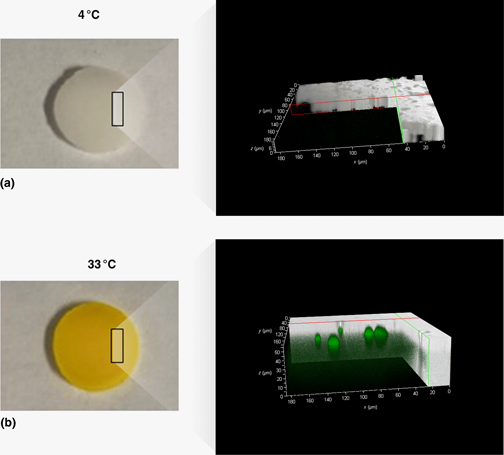Article contents
Loading and release of a model high-molecular-weight protein from temperature-sensitive micro-structured hydrogels
Published online by Cambridge University Press: 28 June 2019
Abstract

The authors prepared a micro-structured, thermosensitive hydrogel with N-isopropylacrylamide microgels with a lower critical solution temperature (LCST) of 32 °C dispersed on a matrix of N-isopropylacrylamide-co-dimethylacrylamide with an LCST at 40 °C. Incubation of the hydrogel at 33 °C in a solution of fluorescein-albumin induced loading of the protein. The protein was not loaded at a temperature below the LCST of the microgels (4 °C), suggesting that the shrinkage of the microgels followed by the formation of micropores within the hydrogel matrix is a prerequisite for protein loading. A sustained and complete release of the loaded protein was obtained at 37 °C.
Information
- Type
- Research Letters
- Information
- Copyright
- Copyright © Materials Research Society 2019
References
1.Zaman, R., Islam, R.A., Ibnat, N., Othman, I., Zaini, A., Lee, C.Y., and Chowdhury, E.H.: Current strategies in extending half-lives of therapeutic proteins. J. Control. Release 301, 179 (2019).Google Scholar
2.Deb, P.K., Al-Attraqchi, O., Chandrasekaran, B., and Paradkar, A.: Basic Fundamentals of Drug Delivery. Advances in Pharmaceutical Product Development and Research. Chapter 16 - Protein/Peptide Drug Delivery Systems: Practical Considerations in Pharmaceutical Product Development (Academic Press, Boston, 2019), pp. 651. https://doi.org/10.1016/B978-0-12-817909-3.00016-9.Google Scholar
3.Vermonden, T., Censi, R., and Hennink, W.E.: Hydrogels for protein delivery. Chem. Rev. 112, 2853 (2012).Google Scholar
4.Yu, M., Wu, J., Shi, J., and Farokhzad, O.C.: Nanotechnology for protein delivery: overview and perspectives. J. Control. Release 240, 24 (2016).Google Scholar
5.Lu, Y., Sun, W., and Gu, Z.: Stimuli-responsive nanomaterials for therapeutic protein delivery. J. Control. Release 194, 1 (2014).Google Scholar
6.Sharpe, L.A., Daily, A.M., Horava, S.D., and Peppas, N.A.: Therapeutic applications of hydrogels in oral drug delivery. Expert Opin. Drug Deliv. 11, 901 (2014).Google Scholar
7.Li, J. and Mooney, D.J.: Designing hydrogels for controlled drug delivery. Nat. Rev. Mater. 1, 16071 (2016).Google Scholar
8.Vashist, A., Vashist, A., Gupta, Y.K., and Ahmad, S.: Recent advances in hydrogel based drug delivery systems for the human body. J. Mater. Chem. B 2, 147 (2014).Google Scholar
9.Taylor, L.D. and Cerankowski, L.D.: Preparation of films exhibiting a balanced temperature dependence to permeation by aqueous solutions – a study of lower consolute behavior. J. Polym. Sci. Polym. Chem. Ed. 13, 2551 (1975).Google Scholar
10.Wu, J.Y., Liu, S.Q., Heng, P.W.S., and Yang, Y.Y.: Evaluating proteins release from, and their interactions with, thermosensitive poly (N-isopropylacrylamide) hydrogels. J. Control. Release 102, 361 (2005).Google Scholar
11.Tanaka, T. and Fillmore, D.J.: Kinetics of swelling of gels. J. Chem. Phys. 70, 1214 (1979).Google Scholar
12.Museh, J., Schneider, S., Lindner, P., and Richtering, W.: Unperturbed volume transition of thermosensitive poly-(N-isopropylacrylamide) microgel particles embedded in a hydrogel matrix. J. Phys. Chem. B 112, 6309 (2008).Google Scholar
13.Palomino, K., Suarez-Meraz, K.A., Serrano-Medina, A., Olivas, A., Samano, E.C., and Cornejo-Bravo, J.M.: Microstructured poly(N-isopropylacrylamide) hydrogels with fast temperature response for pulsatile drug delivery. J. Polym. Res 22(199), 1–9 (2015). https://doi.org/10.1007/s10965-015-0841-0.Google Scholar
14.Palomino, K., Cornejo-Bravo, J.M., Magaña, H., and Serrano-Medina, A.: Microstructured hydrogels with modulated transition temperature for positive control release. Dig. J. Nanomater. Biostruct. 13, 141 (2018).Google Scholar
15.Obeso-Vera, C., Cornejo-Bravo, J.M., Serrano-Medina, A., and Licea-Claverie, A.: Effect of crosslinkers on size and temperature sensitivity of poly(N-isopropylacrylamide) microgels. Polym. Bull 70, 653 (2013).Google Scholar
16.Dash, S., Murthy, P.N., Nath, L., and Chowdhury, P.: Kinetic modeling on drug release from controlled drug delivery systems. Acta Pol. Pharm. 67, 217 (2010).Google Scholar
17.Koshy, S.T., Zhang, D.K.Y., Grolman, J.M., Stafford, A.G., and Mooney, D.J.: Injectable nanocomposite cryogels for versatile protein drug delivery. Acta Biomater. 65, 36 (2018).Google Scholar
18.Perez-Luna, V.H. and Gonzalez-Reynoso, O.: Encapsulation of biological agents in hydrogels for therapeutic applications. Gels 4, 61 (2018).Google Scholar
19.Sabaa, M.W., Hanna, D.H., Abu Elella, M.H., and Mohamed, R.R.: Encapsulation of bovine serum albumin within novel xanthan gum based hydrogel for protein delivery. Mater. Sci. Eng. C 94, 1044 (2019).Google Scholar
20.Egbu, R., Brocchini, S., Khaw, P.T., and Awwad, S.: Antibody loaded collapsible hyaluronic acid hydrogels for intraocular delivery. Eur. J. Pharm. Biopharm. 124, 95 (2018).Google Scholar
21.Dutta, S., Samanta, P., and Dhara, D.: Temperature, pH and redox responsive cellulose based hydrogels for protein delivery. Int. J. Biol. Macromol. 87, 92 (2016).Google Scholar
- 3
- Cited by

